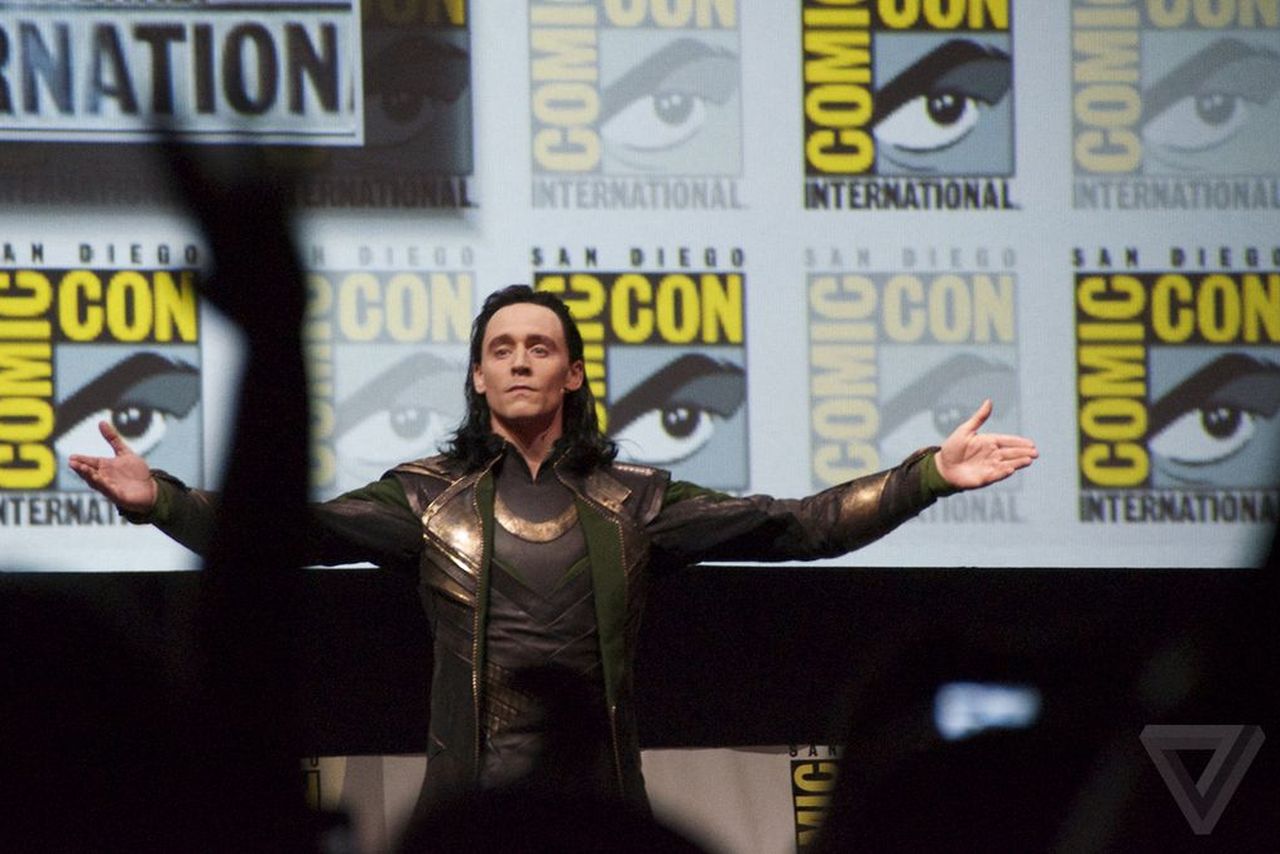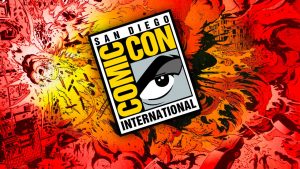
Comic-Con: The Newest Advertising Strategy

Tom Hiddleston is introduced as Loki for the first “Thor” at Comic con 2013.
Every year in the third weekend of July, the San Diego Convention Center fills with stormtroopers and superhero lookalikes signaling the beginning of the 4 day event that is Comic Con International: San Diego, SDCC for short. Comic Con refuses to be ignored from the outpouring of teasing trailers and the #sdcc trending across social media platforms such as Twitter and Tumblr. Comic Con did not begin as a convention that draws fans from all over the world, and causing their 130,000 capacity building to overflow into the surrounding blocks. However, since its inception as a place for enthusiastic fans of comics to meet others who share their interests, Comic Con has become a media circus dueling for attendees attention. Fan culture theorist, Henry Jenkins says that attending companies “emphasize fans as consumers rather than fans as cultural producers.” [i] Comic Con has become another advertising outlet for large studios resulting in the decrease in participation from small companies and individual artists who are unable to compete for the attention of attendees.
Since its inception 46 years ago the 2016 SDCC the convention has morphed into a celebrity and media extravaganza. A group of LA Times writers created a “Timeline” for SDCC, mentioning notable moments which have rippled through time to effect the 2016 event. Comic Con International began in 1970 with a small group of enthusiasts who met in a basement hoping to share and trade vintage comic books.[ii] This founding event only had two comic book specific guests in order to raise funds for a larger convention later the same year. The attendees, who also ran the program, managed to raise the funds and held the first Comic-Con, then called San Diego’s Golden State Comic Con. In Comic Con’s second year the convention brought Kirk Alyn, the first movie star, who played the first live-action Superman in the 1948 film Superman directed by Spencer Gordon Bennet and Thomas Carr. In 1975 the convention became a non-profit which gave the organizers certain benefits still used in 2016, despite some dispute over this non-profit status. George Lucas began the trend of showing sneak peeks of films in 1976 with the first Star Wars (1977). Adam West, the first Batman, made an appearance in 1980, which started the trend of big name celebrities’ regular attendance at the convention. According to the “Timeline” “the Hollywood invasion began,” when the convention moved to its current location at the San Diego Convention Center. More recently, in 2013, television invaded on a large scale. TV shows commandeered the legendary Hall H, known for being the largest hall in the convention holding 6,500 people. This brief history explains where the celebrity appearances, exclusive sneak peeks, and emphasis on TV seen at the 2016 convention originated.

Comic Con Logo
Conglomerate studios such as DC Entertainment and Marvel Entertainment, owned by Warner Brothers and Disney respectively, have transformed the business model of comic con, so that fans are both consumers and advertisers. As a non-profit, Comic Con charges little in comparison to other large scale outlets for advertising. This originally benefitted small companies, but now larger studios are taking advantage of the access to a substantial and enthusiastic audience. Studios do pay a great amount more to have booths and stands on the floor, but they do not have to pay to show clips or book halls for panels on their films. These panels, feature celebrities from both behind and in front of the camera such as J.J. Abrams and Robert Downey Jr., all the studios have to pay for room and board for the celebrities, who do not live nearby. Additionally, all of the panels and clips are intended to be exclusive and not technically allowed to be recorded. This gives fans a greater desire to attend Comic Con, see the celebrities, and be included in a public secret. These panels also provide organic responses that can be used as advertising instead of the artificial tags studios pay to trend on social media. Finally, this is a chance for the studios, such as Marvel, HBO, and so on, to create and debut their transmedia merchandise of toys, video games, and comic books to people who previously might not have been interested lest they came to Comic Con.[iii] All in all, Comic Con allows for large studios to have ease of access to both old and new fans at a prime time to solidify publicity for the fall television schedule and the summer blockbusters. [iv]
Due to the increased popularity and size of the convention, smaller publishers cannot compete with the larger studios for audiences. Small publishers attend comic con with discounts and some art outlets are sponsored by Comic Con to feature artists, however those people are beginning to pull out of the convention. With companies such as DC and Marvel bringing Ryan Reynolds, from Green Lantern (2011) and Deadpool (2015), and Chris Hemsworth, from Thor (2011) and The Avengers (2012), to their panels, the smaller publishers, comic traders, and fanartists have difficulties drawing attention to their booths. For example, NBM Publishing a company which focuses on “literary, mystery, and horror graphic novels,” pulled out of the 2015 Comic Con. Terry Nantier, a publisher at the company, stated that Comic Con had “evolve[d]” and grown and that “indie” conventions were the best for NBM. Matt Hawkins, president of Top Cow Productions did not pull out, but said that both the small companies and attendees have to pay for the cost of room, board, and travel. Therefore attendees are less likely to spend money and the companies are less likely to turn a profit by attending. He went on to say that a smaller comic con in Tulsa, where the tickets were $20-$40 to attend, was where their company made the most money.[v] Tulsa’s ticket prices are significantly cheaper than Comic con’s, which are $40 each for the preview night and shortened Sunday schedule and $55 per day for the Thursday to Friday events for the 2016 convention, which in total is $245 for the whole convention.[vi] Back in 1978, it was only $15 for the full five days or $4 for one day, which is $55.45 and $14.79 respectively with inflation included. The profits from Comic Con are about $15million, $12million of which go towards the expenses of running the convention and the remaining $3million are placed into savings to be used to pay staff and such in case the convention was not able to be held. Comic Con has grown immensely over the last 46 years, but in doing so, it has pushed away some of its smaller groups of comic book traders and fanartists it was initially made to support.[vii]
Comic Con has grown beyond being a meeting place for super fans on the West coast of the United States of America to an International event, unable to be avoided on any social media platform. Large studios use comic con as an advertising platform, taking away the attention from the niche group Comic Con initially formed for. Despite the increase in focus on film and television, Comic Con International’s programing still centers on comics and their data suggests that comics are still the main reason people go to Comic Con. However, they are always trying to get new people who might attend the convention interested in film and leave with a comic book in hand because they might not have gone to a comic book store otherwise.[viii] San Diego Comic Con has definitely been able to attract a wider audience, but it is unclear whether that audience shares the same enthusiasm in comic books as the founding 100.
[i] Jenkins, Henry. “Superpowered Fans: The many worlds of San Diego’s Comic-Con.” Boom: A Journal of California, vol. 2, no. 2, 2012., pp. 22-36. 25.
[ii] Jenkins, 25.
[iii] Cioletti, Amanda. “EXCLUSIVELY COMIC-CON.” License! Global 08 2015: 44-6. ProQuest. Web. 28 July 2016.
[iv] Jenkins, 26.
[v]”San Diego Comic-Con 2015: Is Comic-Con Too Big for Small Publishers?” Publishers Weekly 262.26 (2015): 20,n/a. ProQuest. Web. 28 July 2016.
[vi] http://www.comic-con.org/cci/purchase-badges (due to change in the future)
[vii] Jenkins, 25,33.
[viii] “San Diego Comic-Con 2015: Is Comic-Con Too Big for Small Publishers?”
Comments are closed, but trackbacks and pingbacks are open.